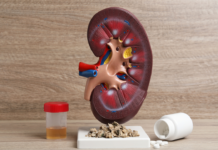For Educational Purposes Only.
The stages of Chronic Kidney Disease are measured by the eGFR (estimated Glomerular Filtration Rate), a mathematical formula using a person’s age, race, gender, and their serum creatinine level. A doctor must order a blood test to measure the serum creatinine level. Creatinine is a waste product that comes from muscle activity, when kidneys are working well, they remove creatinine from the blood1. As kidney function slows, blood levels of creatinine rise1. There are five stages of kidney disease, with stage I being normal function, and stage V being very severe or resulting in failure.
In stages I and II of CKD, the kidneys are still functioning normally. There aren’t really any symptoms, so people will usually find out they have stage I if they are being tested for something else such as diabetes or high blood pressure. Some of the symptoms may include higher than normal levels of creatinine or urea in the blood, blood or protein in the urine, evidence of kidney damage in an MRI, CT scan, ultrasound, or contrast X-ray, and a family history of Polycystic Kidney Disease(PKD)2.
In stage III of kidney disease, the kidney has moderate damage. This stage is broken up into two stages: 3A and 3B. As kidney function declines waste products can build up in the blood causing a condition known as “uremia”3. In stage III a person is more likely to develop complications of kidney disease such as high blood pressure, anemia (a shortage of red blood cells) and/or early bone disease3. Some symptoms that may become present include fatigue, fluid retention, shortness of breath, urination changes, kidney pain (felt in back), and or sleep problems due to muscle cramps and restless legs3. Stage III is when you need to start seeing a nephrologist, manage a healthy diet supporting kidney health, and maybe even start taking prescribed medication. Usually a doctor will prescribe a medication for blood pressure to ensure it doesn’t rise too much.
Stage IV kidney disease entails advanced kidney damage and means that a person will probably have to start dialysis or have a kidney transplant in the near future. At this point a person may develop bone disease, heart disease, and other cardiovascular diseases4. The same symptoms from earlier stages will continue, as well as the addition of nausea and vomiting, taste changes (metallic), bad breath, loss of appetite, difficulty concentrating,and nerve problems such as numbness or tingling4. People in stage IV CKD will usually visit their doctor at least every three months, blood tests for creatinine, hemoglobin, calcium and phosphorus levels will be administered to check how well the kidneys are working4. The doctor will also monitor other conditions such as high blood pressure and diabetes4. In addition to helping the patient keep their kidneys working as long as possible, the nephrologist will also help prepare the patient for dialysis or a kidney transplant.
A person with stage V Chronic Kidney Disease has End Stage Renal Disease (ESRD) with a glomerular filtration rate (GFR) of 15 ml/min or less5. At this advanced stage of Kidney Disease, the kidneys have lost nearly all their ability to do their job effectively, and eventually dialysis or a kidney transplant is needed to live5. The symptoms from earlier stages will persist, as well as changes in skin color or increased pigmentation, and an overall ill feeling because of toxins built up in the blood5. Most people report feeling much better once they begin dialysis. There are two types of dialysis treatments for people with stage V Kidney Disease.
One is hemodialysis, which can be done in a center or in a patient’s home with assistance from a care partner. A dialysis machine removes a small amount of a patient’s blood through a man-made membrane called a dialyzer, or artificial kidney, to clean out toxins that the kidneys can no longer remove,the filtered blood is then returned to the body5. Another is peritoneal dialysis, which is a needle-free treatment that can be performed at home or at work5. A care partner is not required to help assist during treatment. To get a kidney transplant, a nephrologist will have to put you on a waiting list for a cadaverous kidney or one from a donor. When at stage V CKD, either dialysis or a kidney transplant is necessary to continue living.
Sponsor: Kibow Biotech® 
References:
- National Kidney Foundation. (2018, September 17). Understanding Your Lab Values. Retrieved from https://www.kidney.org/atoz/content/understanding-your-lab-values
- Davita Kidney Care. (2004-2019). Stage 1 of chronic kidney disease CKD. Retrieved from https:// www.davita.com/education/kidney-disease/stages/stage-1-of-chronic-kidney-disease
- Davita Kidney Care. (2004-2019). Stage 3 of chronic kidney disease CKD. Retrieved from https:// www.davita.com/education/kidney-disease/stages/stage-3-of-chronic-kidney-disease
- Davita Kidney Care. (2004-2019). Stage 4 of chronic kidney disease CKD. Retrieved from https:// www.davita.com/education/kidney-disease/stages/stage-4-of-chronic-kidney-disease
- Davita Kidney Care. (2004-2019). Stage 5 of chronic kidney disease CKD. Retrieved from https:// www.davita.com/education/kidney-disease/stages/stage-5-of-chronic-kidney-disease




